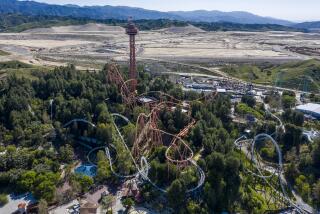The Theme Park Watch
- Share via
One of the benefits of living in Southern California is the proximity of a rich variety of theme parks for family entertainment. How to ensure that the rides are safe has become the subject of debate.
When families from the San Fernando Valley go to Six Flags Magic Mountain, or those from Orange County go to Disneyland, it’s unlikely they ask whether safety is the jurisdiction of the federal government, the state or local authorities. But people do want to be assured that somebody is looking out for their safety. The best guarantee of that is to build in independent review.
The fatal accident at the sailing ship Columbia at Disneyland last Christmas Eve has been a catalyst for a reexamination of safety procedures. Safety standards do vary from state to state. Efforts to set national standards have faltered. In states around the country can be found everything from Florida’s inspections for all but the biggest parks to the 12 states, including California, that do not regulate permanent amusement parks at all.
The recent Cal/OSHA report on the Disneyland accident clarified the options before this state. Common sense suggests that allowing theme parks to certify to their own safety, as one assemblyman originally proposed, was not a good idea. Its flabbiness was revealed when state investigators found that Disneyland had violated its own policy manual on training for the operation of the Columbia ride. If state investigators could demonstrate that a theme park did not meet even its own standards, then any declaration without an independent review could not be counted on.
Without independent oversight, safety violations, or lapses in meeting a particular park’s own standards, might not turn up.
Accordingly, the best and most sensible option to date for reviewing park safety remains the proposal of Assemblyman Tom Torlakson (D-Antioch), who is sponsoring legislation that would require state inspections of parks and that parks report accidents publicly. That bill is scheduled for a committee hearing on April 21.
The value of independent inspections has been time-tested at Six Flags Magic Mountain in Valencia. Since opening in 1971, the park has been inspected every 90 days by a Los Angeles County inspector. The park pays for the cost of the inspector’s time. The park also is on record as supporting the concept of state inspections.
In Texas, this idea gained some momentum recently from an accident at Six Flags Over Texas in Arlington when a raft overturned and a woman drowned. Texas has required only that parks hire outside inspectors and file safety reports. Of course, there is nothing to ensure that state inspectors for California would find things that hired inspectors wouldn’t. But it’s an additional layer of independent oversight. This leads to another important point: Even independent inspectors need to double-check high-risk areas.
For the safety of the public, the choice between self-evaluation and independent evaluation at theme parks is clear. That’s why the approach being outlined by Torlakson for independent inspections is worth adopting.


